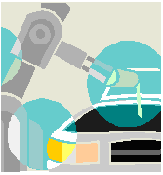 |
 |
Sensors and Intelligence
|
 The industrial robotics market keeps growing at about 8 percent annually toward about $5 billion a year over the next few years. Long-awaited burgeoning growth continues to elude this market because the current generation of products still yields only incremental improvements in manufacturing processes.
The industrial robotics market keeps growing at about 8 percent annually toward about $5 billion a year over the next few years. Long-awaited burgeoning growth continues to elude this market because the current generation of products still yields only incremental improvements in manufacturing processes.
In the '70s, robots were introduced for the automation of a wide spectrum of tasks: automobile and electronics assembly, machining of metal and plastic parts, and handling of production items of all kinds. To this day, the automotive and electronics industries and their supply chains are the main users of robot systems, accounting for more than 60 percent of total annual industrial robotics sales. Today, customers consider industrial robots primarily from the viewpoint of faster manufacturing cycle times. In countries that are traditionally considered large robotics markets, the growth of the installed base has slowed, and only new small and medium-sized factories are considering robotics solutions for more efficient customized production in smaller lots. The ability to customize, and production speed, are primary market factors. Industrial robots have three aspects - bone (linkages), brawn (motive power) and brain (intelligence). While technology advances continue to improve the first two (e.g. improved materials; powerful, light-weight motors), the third aspect yields revolutionary performance. For example, for more precise guidance, robots often contain machine-vision subsystems acting as their "eyes." Improved sensing and related artificial intelligence are becoming increasingly important factors from which new growth inflection points will emerge. Technology continues to accelerate the intrinsic performance of robotics technology to levels where breakthroughs continue to occur. You may recall the March 2004 DARPA race for autonomous automobiles traveling over natural terrain. This ended as a bust - no one won the coveted $1 million prize. Less than two years later, in October 2005, the race was held again, and DARPA doubled the prize; rather than make it easier, they designed a much more difficult course. There was a dramatic technology leap; five entries crossed the finish line and the fastest was judged the winner. Currently, there are only a handful of large industrial robotics manufacturers in the world—the list includes ABB, Fanuc, Kuka, Yaskawa (Motoman) and a sprinkling of other not-so-well-known companies. Founded in 1983, Adept Technology, from Livermore, Calif., is the largest U.S.-based manufacturer of industrial robots, with about $50 million in annual sales and, after 25 years, is still not profitable. By contrast, iRobot Corp., headquartered in Burlington, Mass., manufactures robots for consumer, government and industrial markets, with 2007 revenues of about $200 million. Founded in 1990, the company didn’t really expand until about 2000, and now offers consumer products, including floor vacuuming and washing robots such as Roomba (I've owned own one since 2003, and am still pleased with its performance). iRobot has also developed industrial and government products, including portable, tactical and mobile robots for military operations in urban terrain and battle missions. In my opinion, some iRobot technologies can and should be adapted to industrial applications and markets. Future robot systems cannot be a mere extrapolation of today's technology, but should generate whole new application arenas through revolutionary sensors and artificial-intelligence extensions to stimulate new levels of manufacturing competence. This kind of robotics will become a key component in the digital factory of the future. Beyond humanWhile we still tend to imagine robots in terms of science fiction adventures and movies, modifying an old Webster's definition turns out to be a pretty good one for tomorrow’s industrial robot. The original read, "an automatic apparatus or device that performs functions ordinarily ascribed to humans or operates with what appears to be almost human intelligence," which might extend to include, "extends sensing and intelligence beyond human capabilities."
|
 Pinto's Points How to win in the Automation Business Go shopping - books, electronics, CD/DVD Selected advertising coming here. Contact Jim Pinto for rates. |
Return to Index of all JimPinto Writings

 Return to JimPinto.com HomePage
Return to JimPinto.com HomePage
If you have ideas or suggestions to improve this site, contact: webmaster@jimpinto.com
Copyright 2006 : Jim Pinto, San Diego, CA, USA
